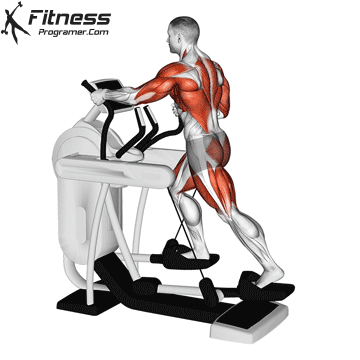Contents
- What Is an Elliptical Machine and How Does It Work?
- Is 30 Minutes of Elliptical a Day Enough?
- What 30 Minutes of Elliptical Can Do for You
- Factors That Influence Results
- When Is 30 Minutes Not Enough?
- How to Make 30 Minutes on the Elliptical More Effective
- Sample 30-Minute Elliptical Workout (Interval Format)
- Conclusion
The elliptical machine is a popular low-impact cardio option found in most gyms and homes. It’s praised for being easy on the joints, effective for burning calories, and suitable for all fitness levels. But a common question arises: Is 30 minutes of elliptical a day enough?
The answer depends on your goals—whether it’s fat loss, cardiovascular health, endurance, or maintenance. This article breaks down what 30 minutes of elliptical daily can realistically achieve, how it compares to other cardio methods, and how to tailor it for your unique objectives.
What Is an Elliptical Machine and How Does It Work?
The elliptical trainer is a stationary cardio machine that mimics the motion of walking, jogging, or climbing stairs—without the impact. It allows for a smooth, gliding movement, which is easier on the knees, hips, and back than high-impact exercises like running.
Most elliptical machines engage both the upper and lower body, making them a full-body cardiovascular option that’s ideal for endurance, calorie burning, and recovery days.

Is 30 Minutes of Elliptical a Day Enough?
Yes—30 minutes of elliptical per day can be sufficient for improving general health, cardiovascular endurance, and weight management, especially if paired with a healthy diet and strength training. However, how effective it is depends on several key factors.
What 30 Minutes of Elliptical Can Do for You
1. Cardiovascular Health
The American Heart Association recommends at least 150 minutes per week of moderate-intensity aerobic exercise. A daily 30-minute elliptical session hits 210 minutes/week, exceeding that guideline.
Benefits include:
- Lower resting heart rate
- Improved VO₂ max (aerobic capacity)
- Reduced blood pressure
- Improved circulation and heart health
2. Calorie Burn and Weight Loss
Depending on body weight, age, and intensity, a 30-minute elliptical session can burn:
- Approx. 240–400 calories for a person weighing 150–180 lbs
In combination with a caloric deficit, this can contribute meaningfully to fat loss over time. For example, burning 300 calories/day through cardio could contribute to 1–2 lbs of fat loss per month, assuming nutrition is aligned.
3. Low-Impact Conditioning
Unlike treadmills or outdoor running, ellipticals are joint-friendly and suitable for:
- People with arthritis or joint injuries
- Active recovery
- Beginners new to exercise
4. Muscle Endurance and Stability
Using the elliptical’s handlebars engages the upper body, including the:
- Shoulders
- Arms
- Core
The continuous motion of the legs strengthens the quads, glutes, hamstrings, and calves, building muscular endurance without the wear-and-tear of high-impact movement.
Factors That Influence Results
| Factor | How It Impacts Effectiveness |
|---|---|
| Workout Intensity | Higher resistance or interval-style training increases calorie burn |
| Body Composition Goals | You’ll need to pair cardio with strength training for lean mass preservation |
| Nutrition | Exercise alone won’t offset a calorie surplus; fat loss requires dietary alignment |
| Duration and Consistency | Daily consistency is more important than occasional high-intensity workouts |
| Rest and Recovery | Overdoing cardio without recovery can lead to fatigue or muscle breakdown |
When Is 30 Minutes Not Enough?
- If your goal is advanced fat loss (e.g., losing more than 1–2 lbs/week)
- If you’re training for endurance sports or events longer than 5K
- If you’re neglecting strength training and aiming for body recomposition
- If intensity is too low (i.e., reading a book while gliding casually)
In these cases, you may need to:
- Add resistance or interval training
- Extend duration to 45–60 minutes a few times per week
- Incorporate weight training 2–3x/week
How to Make 30 Minutes on the Elliptical More Effective
1. Use Interval Training (HIIT)
Alternate between:
- 1–2 minutes of high resistance/speed
- 1 minute of low resistance recovery
This boosts EPOC (Excess Post-Exercise Oxygen Consumption), helping burn more calories post-workout.
2. Adjust Resistance and Incline
Use the machine’s features to challenge the muscles and increase energy expenditure.
3. Engage Full Range of Motion
Focus on activating your glutes, core, and upper body by using the arms and proper posture (don’t lean on the handles).
4. Combine with Strength Training
Even 2–3 days of resistance training will preserve muscle mass and enhance fat loss when paired with daily elliptical work.
Sample 30-Minute Elliptical Workout (Interval Format)
| Time | Intensity/Instructions |
|---|---|
| 0–5 min | Warm-up, low resistance |
| 5–10 min | Moderate pace, steady state |
| 10–20 min | Alternate 1 min high resistance / 1 min low |
| 20–25 min | Moderate incline, steady state |
| 25–30 min | Cool down, low resistance |
Conclusion
Yes—30 minutes on the elliptical a day is enough for most people to support heart health, manage weight, and maintain a consistent exercise habit. For general fitness, it meets or exceeds most health guidelines. But if your goal is muscle gain, body recomposition, or aggressive fat loss, you’ll benefit from adding resistance training, nutritional planning, and higher-intensity cardio.
The elliptical remains a versatile, low-impact tool that can fit into any training program—from beginners to advanced athletes—when used intentionally.
References
- American College of Sports Medicine. ACSM’s Guidelines for Exercise Testing and Prescription, 11th Edition.
- Garber CE, et al. Quantity and quality of exercise for developing and maintaining cardiorespiratory, musculoskeletal, and neuromotor fitness. Med Sci Sports Exerc. 2011;43(7):1334–1359.
- Swift DL, et al. The role of exercise and physical activity in weight loss and maintenance. Prog Cardiovasc Dis. 2014;56(4):441–447.
- Gaesser GA, Angadi SS. Obesity treatment: Weight loss versus increasing fitness and physical activity for reducing health risks. Science. 2021;24(9):102995.



